Accounting and Finance Assessment for UGB 163 at Sunderland University
VerifiedAdded on 2023/01/05
|22
|3794
|58
Homework Assignment
AI Summary
This document provides a complete solution to the UGB 163 Introduction to Accounting and Finance assessment, covering key aspects of financial and managerial accounting. The solution includes a detailed analysis of financial statements for Collins Colman Limited, encompassing the preparation of an income statement and a statement of financial position. Furthermore, it delves into cost accounting, including break-even analysis, margin of safety, and profit calculations for Parks Mead Limited. Finally, the document presents an investment appraisal for Skipsey Clifford Plc, calculating the payback period, accounting rate of return (ARR), and net present value (NPV), alongside a discussion of the merits and limitations of various investment appraisal techniques. The assignment addresses fundamental accounting principles and their practical applications, with a focus on financial statement analysis and investment decision-making.
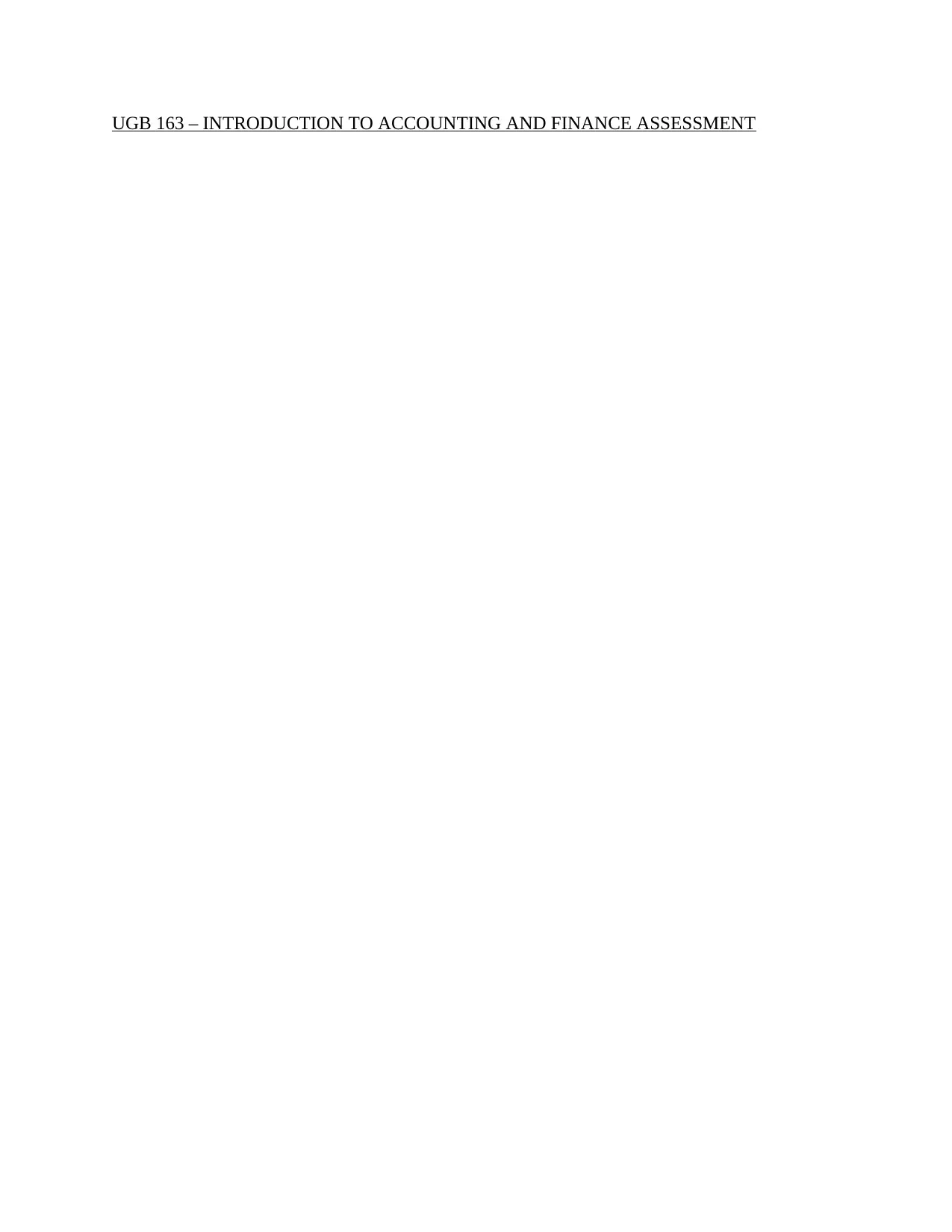
UGB 163 – INTRODUCTION TO ACCOUNTING AND FINANCE ASSESSMENT
Paraphrase This Document
Need a fresh take? Get an instant paraphrase of this document with our AI Paraphraser
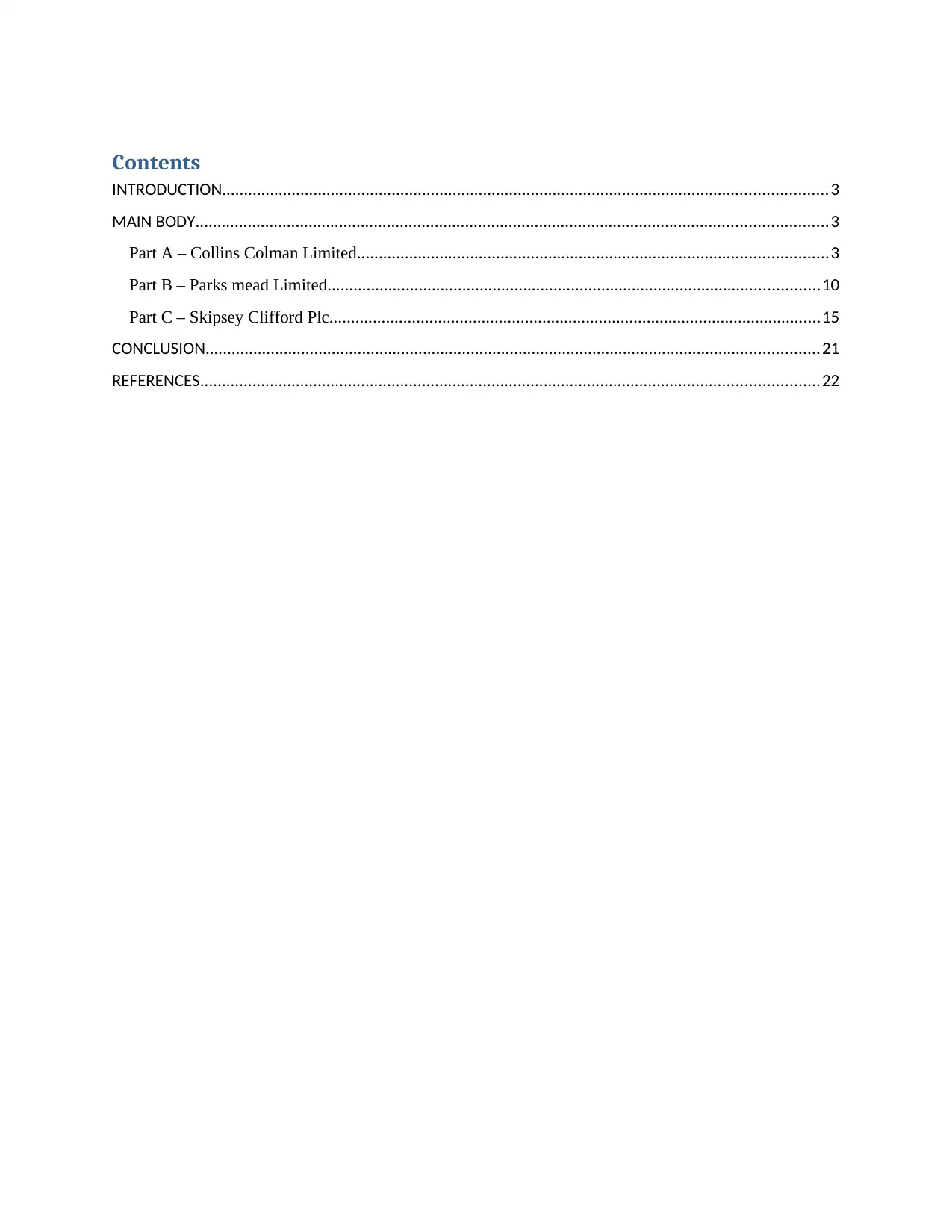
Contents
INTRODUCTION...........................................................................................................................................3
MAIN BODY.................................................................................................................................................3
Part A – Collins Colman Limited............................................................................................................3
Part B – Parks mead Limited.................................................................................................................10
Part C – Skipsey Clifford Plc.................................................................................................................15
CONCLUSION.............................................................................................................................................21
REFERENCES..............................................................................................................................................22
INTRODUCTION...........................................................................................................................................3
MAIN BODY.................................................................................................................................................3
Part A – Collins Colman Limited............................................................................................................3
Part B – Parks mead Limited.................................................................................................................10
Part C – Skipsey Clifford Plc.................................................................................................................15
CONCLUSION.............................................................................................................................................21
REFERENCES..............................................................................................................................................22
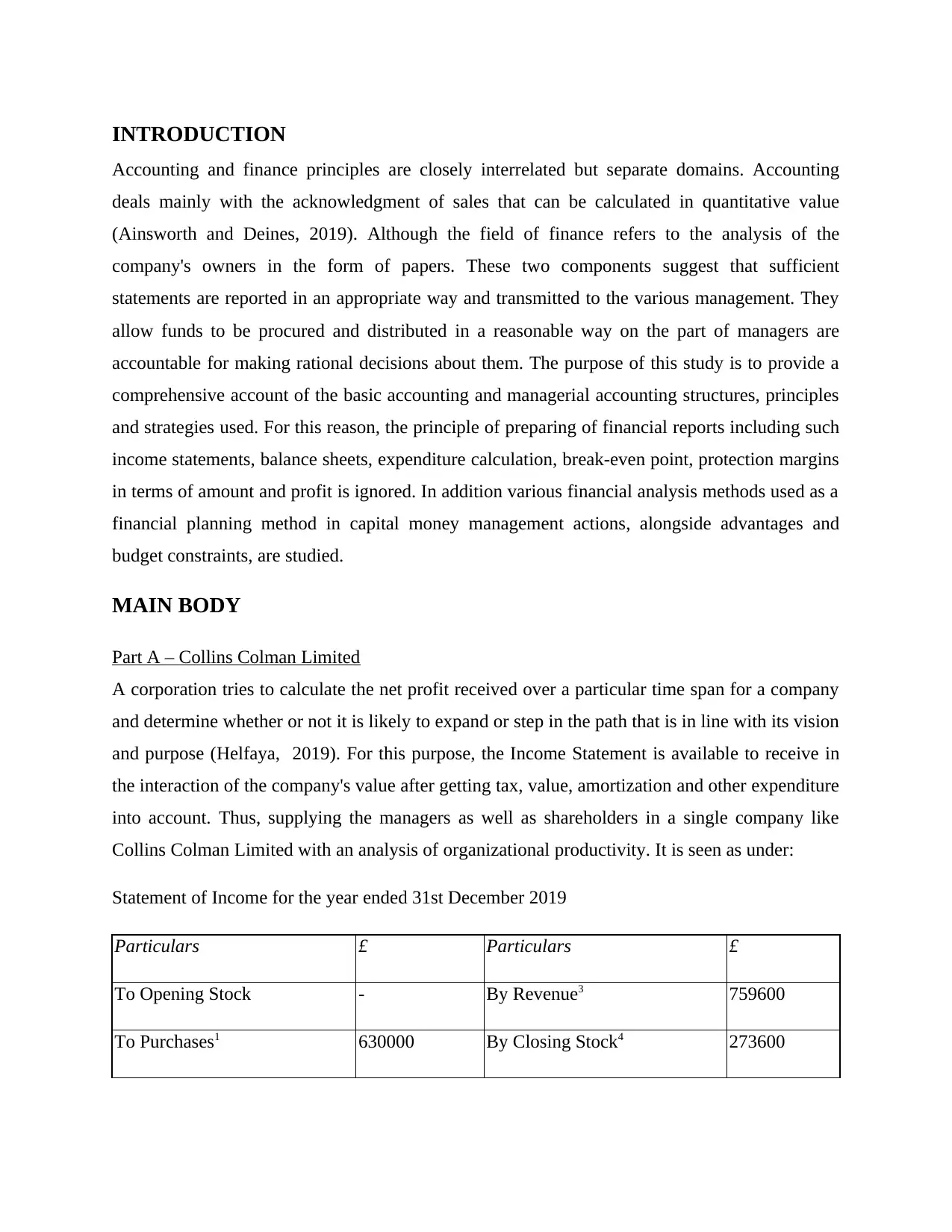
INTRODUCTION
Accounting and finance principles are closely interrelated but separate domains. Accounting
deals mainly with the acknowledgment of sales that can be calculated in quantitative value
(Ainsworth and Deines, 2019). Although the field of finance refers to the analysis of the
company's owners in the form of papers. These two components suggest that sufficient
statements are reported in an appropriate way and transmitted to the various management. They
allow funds to be procured and distributed in a reasonable way on the part of managers are
accountable for making rational decisions about them. The purpose of this study is to provide a
comprehensive account of the basic accounting and managerial accounting structures, principles
and strategies used. For this reason, the principle of preparing of financial reports including such
income statements, balance sheets, expenditure calculation, break-even point, protection margins
in terms of amount and profit is ignored. In addition various financial analysis methods used as a
financial planning method in capital money management actions, alongside advantages and
budget constraints, are studied.
MAIN BODY
Part A – Collins Colman Limited
A corporation tries to calculate the net profit received over a particular time span for a company
and determine whether or not it is likely to expand or step in the path that is in line with its vision
and purpose (Helfaya, 2019). For this purpose, the Income Statement is available to receive in
the interaction of the company's value after getting tax, value, amortization and other expenditure
into account. Thus, supplying the managers as well as shareholders in a single company like
Collins Colman Limited with an analysis of organizational productivity. It is seen as under:
Statement of Income for the year ended 31st December 2019
Particulars £ Particulars £
To Opening Stock - By Revenue3 759600
To Purchases1 630000 By Closing Stock4 273600
Accounting and finance principles are closely interrelated but separate domains. Accounting
deals mainly with the acknowledgment of sales that can be calculated in quantitative value
(Ainsworth and Deines, 2019). Although the field of finance refers to the analysis of the
company's owners in the form of papers. These two components suggest that sufficient
statements are reported in an appropriate way and transmitted to the various management. They
allow funds to be procured and distributed in a reasonable way on the part of managers are
accountable for making rational decisions about them. The purpose of this study is to provide a
comprehensive account of the basic accounting and managerial accounting structures, principles
and strategies used. For this reason, the principle of preparing of financial reports including such
income statements, balance sheets, expenditure calculation, break-even point, protection margins
in terms of amount and profit is ignored. In addition various financial analysis methods used as a
financial planning method in capital money management actions, alongside advantages and
budget constraints, are studied.
MAIN BODY
Part A – Collins Colman Limited
A corporation tries to calculate the net profit received over a particular time span for a company
and determine whether or not it is likely to expand or step in the path that is in line with its vision
and purpose (Helfaya, 2019). For this purpose, the Income Statement is available to receive in
the interaction of the company's value after getting tax, value, amortization and other expenditure
into account. Thus, supplying the managers as well as shareholders in a single company like
Collins Colman Limited with an analysis of organizational productivity. It is seen as under:
Statement of Income for the year ended 31st December 2019
Particulars £ Particulars £
To Opening Stock - By Revenue3 759600
To Purchases1 630000 By Closing Stock4 273600
⊘ This is a preview!⊘
Do you want full access?
Subscribe today to unlock all pages.

Trusted by 1+ million students worldwide
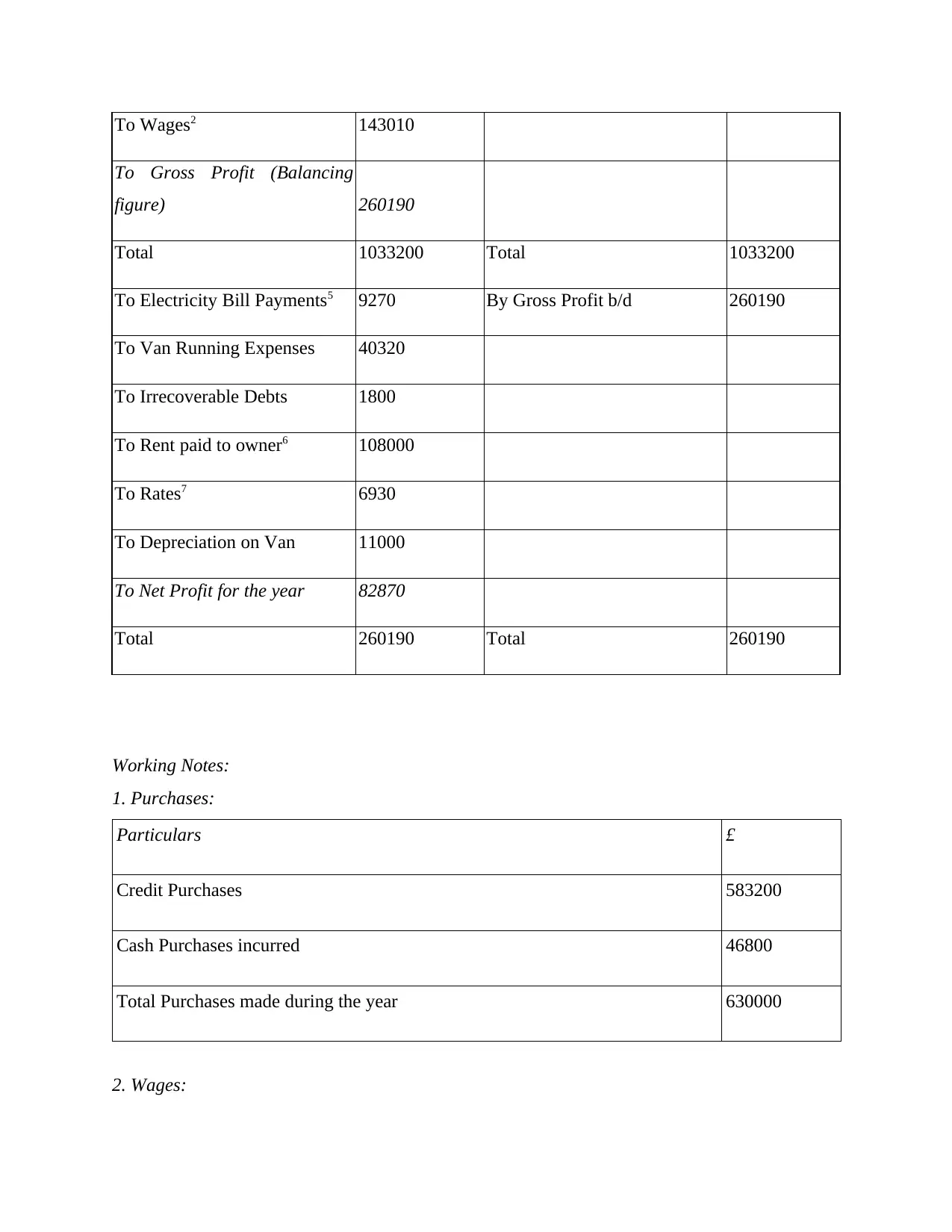
To Wages2 143010
To Gross Profit (Balancing
figure) 260190
Total 1033200 Total 1033200
To Electricity Bill Payments5 9270 By Gross Profit b/d 260190
To Van Running Expenses 40320
To Irrecoverable Debts 1800
To Rent paid to owner6 108000
To Rates7 6930
To Depreciation on Van 11000
To Net Profit for the year 82870
Total 260190 Total 260190
Working Notes:
1. Purchases:
Particulars £
Credit Purchases 583200
Cash Purchases incurred 46800
Total Purchases made during the year 630000
2. Wages:
To Gross Profit (Balancing
figure) 260190
Total 1033200 Total 1033200
To Electricity Bill Payments5 9270 By Gross Profit b/d 260190
To Van Running Expenses 40320
To Irrecoverable Debts 1800
To Rent paid to owner6 108000
To Rates7 6930
To Depreciation on Van 11000
To Net Profit for the year 82870
Total 260190 Total 260190
Working Notes:
1. Purchases:
Particulars £
Credit Purchases 583200
Cash Purchases incurred 46800
Total Purchases made during the year 630000
2. Wages:
Paraphrase This Document
Need a fresh take? Get an instant paraphrase of this document with our AI Paraphraser
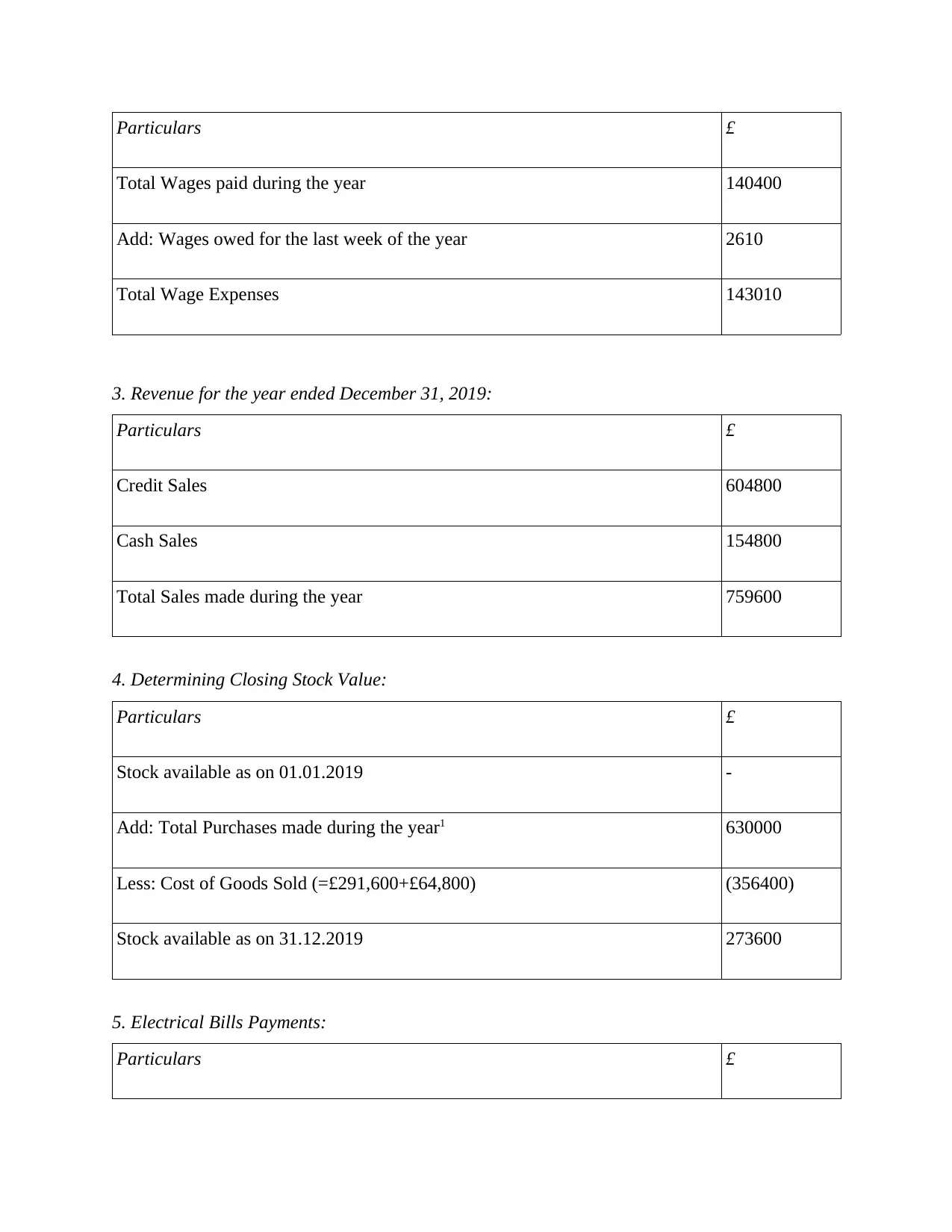
Particulars £
Total Wages paid during the year 140400
Add: Wages owed for the last week of the year 2610
Total Wage Expenses 143010
3. Revenue for the year ended December 31, 2019:
Particulars £
Credit Sales 604800
Cash Sales 154800
Total Sales made during the year 759600
4. Determining Closing Stock Value:
Particulars £
Stock available as on 01.01.2019 -
Add: Total Purchases made during the year1 630000
Less: Cost of Goods Sold (=£291,600+£64,800) (356400)
Stock available as on 31.12.2019 273600
5. Electrical Bills Payments:
Particulars £
Total Wages paid during the year 140400
Add: Wages owed for the last week of the year 2610
Total Wage Expenses 143010
3. Revenue for the year ended December 31, 2019:
Particulars £
Credit Sales 604800
Cash Sales 154800
Total Sales made during the year 759600
4. Determining Closing Stock Value:
Particulars £
Stock available as on 01.01.2019 -
Add: Total Purchases made during the year1 630000
Less: Cost of Goods Sold (=£291,600+£64,800) (356400)
Stock available as on 31.12.2019 273600
5. Electrical Bills Payments:
Particulars £
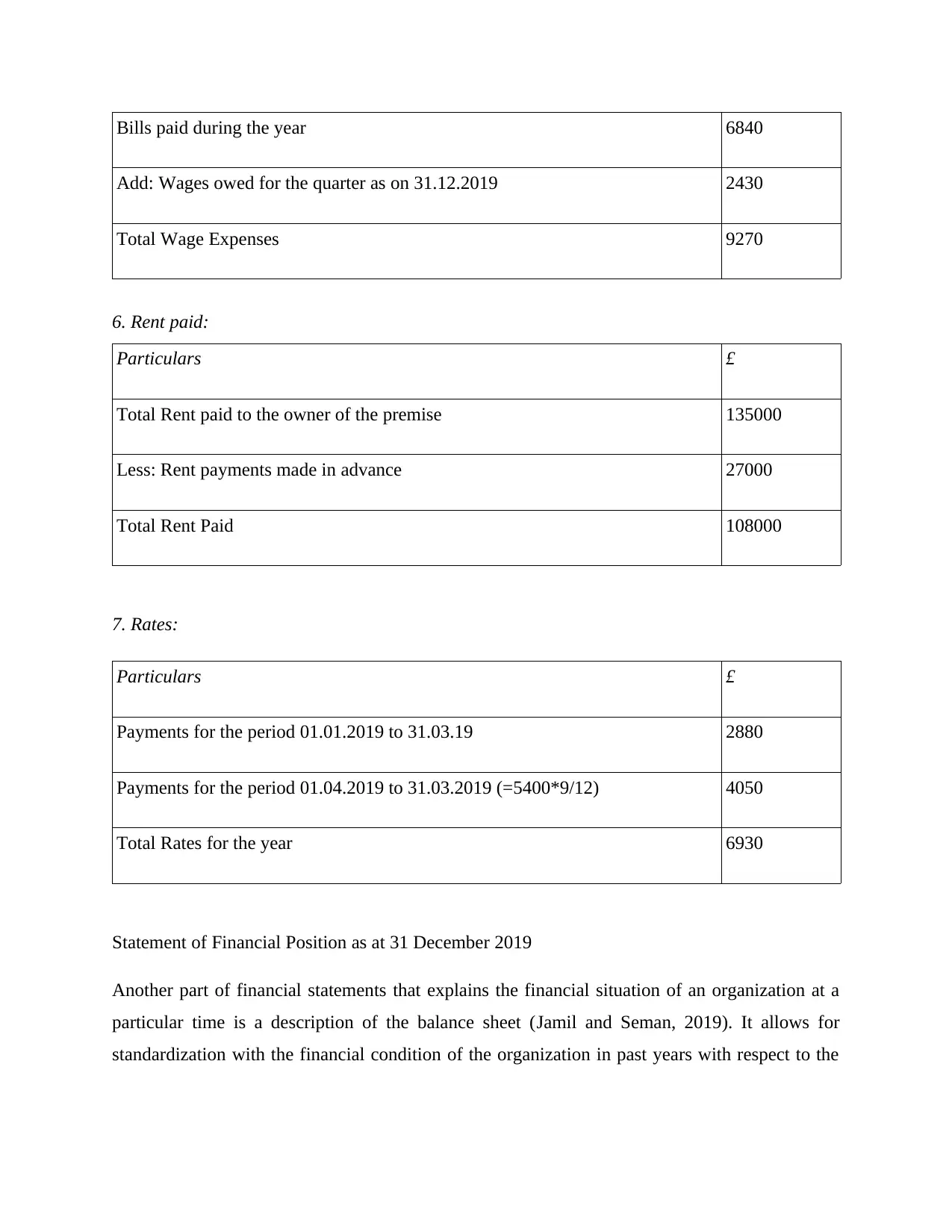
Bills paid during the year 6840
Add: Wages owed for the quarter as on 31.12.2019 2430
Total Wage Expenses 9270
6. Rent paid:
Particulars £
Total Rent paid to the owner of the premise 135000
Less: Rent payments made in advance 27000
Total Rent Paid 108000
7. Rates:
Particulars £
Payments for the period 01.01.2019 to 31.03.19 2880
Payments for the period 01.04.2019 to 31.03.2019 (=5400*9/12) 4050
Total Rates for the year 6930
Statement of Financial Position as at 31 December 2019
Another part of financial statements that explains the financial situation of an organization at a
particular time is a description of the balance sheet (Jamil and Seman, 2019). It allows for
standardization with the financial condition of the organization in past years with respect to the
Add: Wages owed for the quarter as on 31.12.2019 2430
Total Wage Expenses 9270
6. Rent paid:
Particulars £
Total Rent paid to the owner of the premise 135000
Less: Rent payments made in advance 27000
Total Rent Paid 108000
7. Rates:
Particulars £
Payments for the period 01.01.2019 to 31.03.19 2880
Payments for the period 01.04.2019 to 31.03.2019 (=5400*9/12) 4050
Total Rates for the year 6930
Statement of Financial Position as at 31 December 2019
Another part of financial statements that explains the financial situation of an organization at a
particular time is a description of the balance sheet (Jamil and Seman, 2019). It allows for
standardization with the financial condition of the organization in past years with respect to the
⊘ This is a preview!⊘
Do you want full access?
Subscribe today to unlock all pages.

Trusted by 1+ million students worldwide
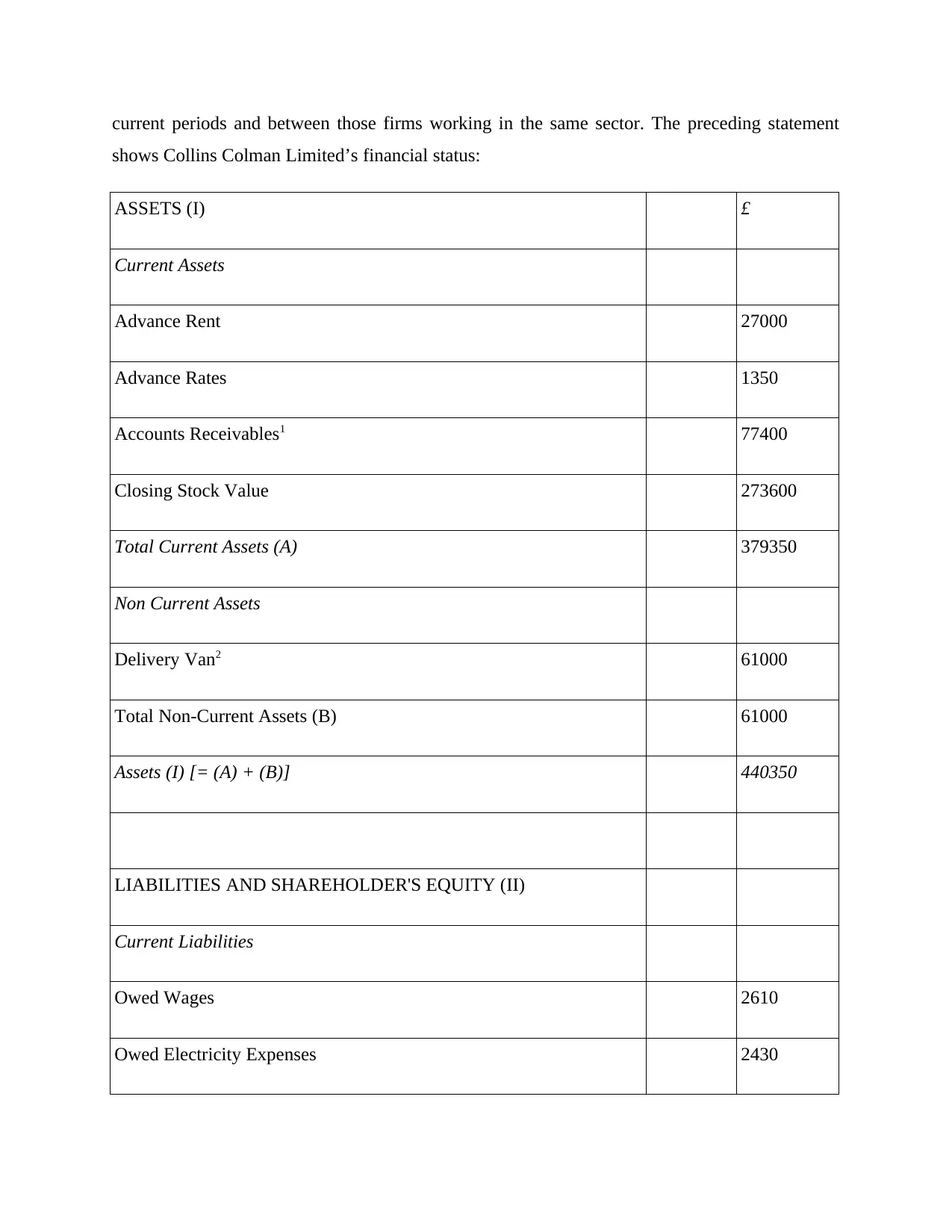
current periods and between those firms working in the same sector. The preceding statement
shows Collins Colman Limited’s financial status:
ASSETS (I) £
Current Assets
Advance Rent 27000
Advance Rates 1350
Accounts Receivables1 77400
Closing Stock Value 273600
Total Current Assets (A) 379350
Non Current Assets
Delivery Van2 61000
Total Non-Current Assets (B) 61000
Assets (I) [= (A) + (B)] 440350
LIABILITIES AND SHAREHOLDER'S EQUITY (II)
Current Liabilities
Owed Wages 2610
Owed Electricity Expenses 2430
shows Collins Colman Limited’s financial status:
ASSETS (I) £
Current Assets
Advance Rent 27000
Advance Rates 1350
Accounts Receivables1 77400
Closing Stock Value 273600
Total Current Assets (A) 379350
Non Current Assets
Delivery Van2 61000
Total Non-Current Assets (B) 61000
Assets (I) [= (A) + (B)] 440350
LIABILITIES AND SHAREHOLDER'S EQUITY (II)
Current Liabilities
Owed Wages 2610
Owed Electricity Expenses 2430
Paraphrase This Document
Need a fresh take? Get an instant paraphrase of this document with our AI Paraphraser
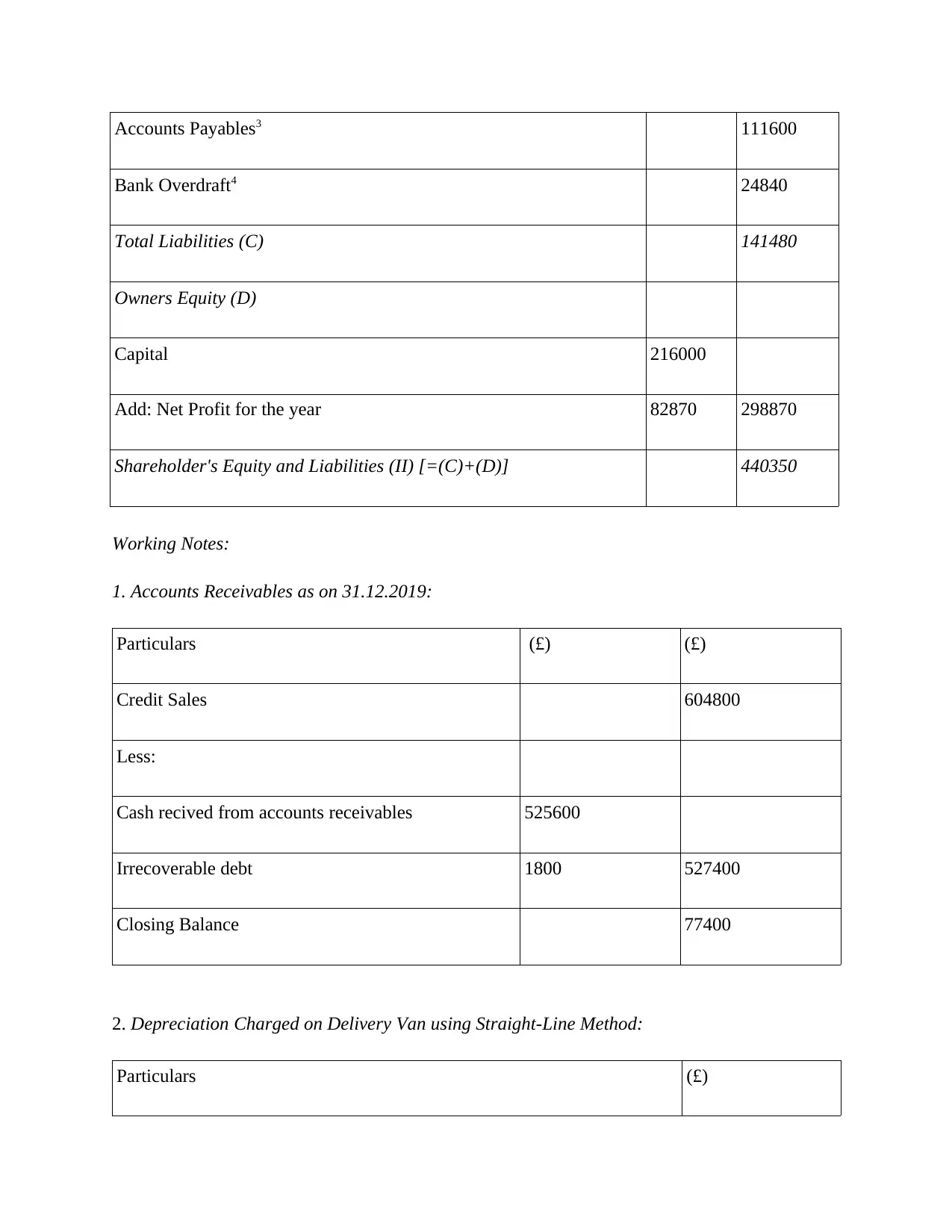
Accounts Payables3 111600
Bank Overdraft4 24840
Total Liabilities (C) 141480
Owners Equity (D)
Capital 216000
Add: Net Profit for the year 82870 298870
Shareholder's Equity and Liabilities (II) [=(C)+(D)] 440350
Working Notes:
1. Accounts Receivables as on 31.12.2019:
Particulars (£) (£)
Credit Sales 604800
Less:
Cash recived from accounts receivables 525600
Irrecoverable debt 1800 527400
Closing Balance 77400
2. Depreciation Charged on Delivery Van using Straight-Line Method:
Particulars (£)
Bank Overdraft4 24840
Total Liabilities (C) 141480
Owners Equity (D)
Capital 216000
Add: Net Profit for the year 82870 298870
Shareholder's Equity and Liabilities (II) [=(C)+(D)] 440350
Working Notes:
1. Accounts Receivables as on 31.12.2019:
Particulars (£) (£)
Credit Sales 604800
Less:
Cash recived from accounts receivables 525600
Irrecoverable debt 1800 527400
Closing Balance 77400
2. Depreciation Charged on Delivery Van using Straight-Line Method:
Particulars (£)
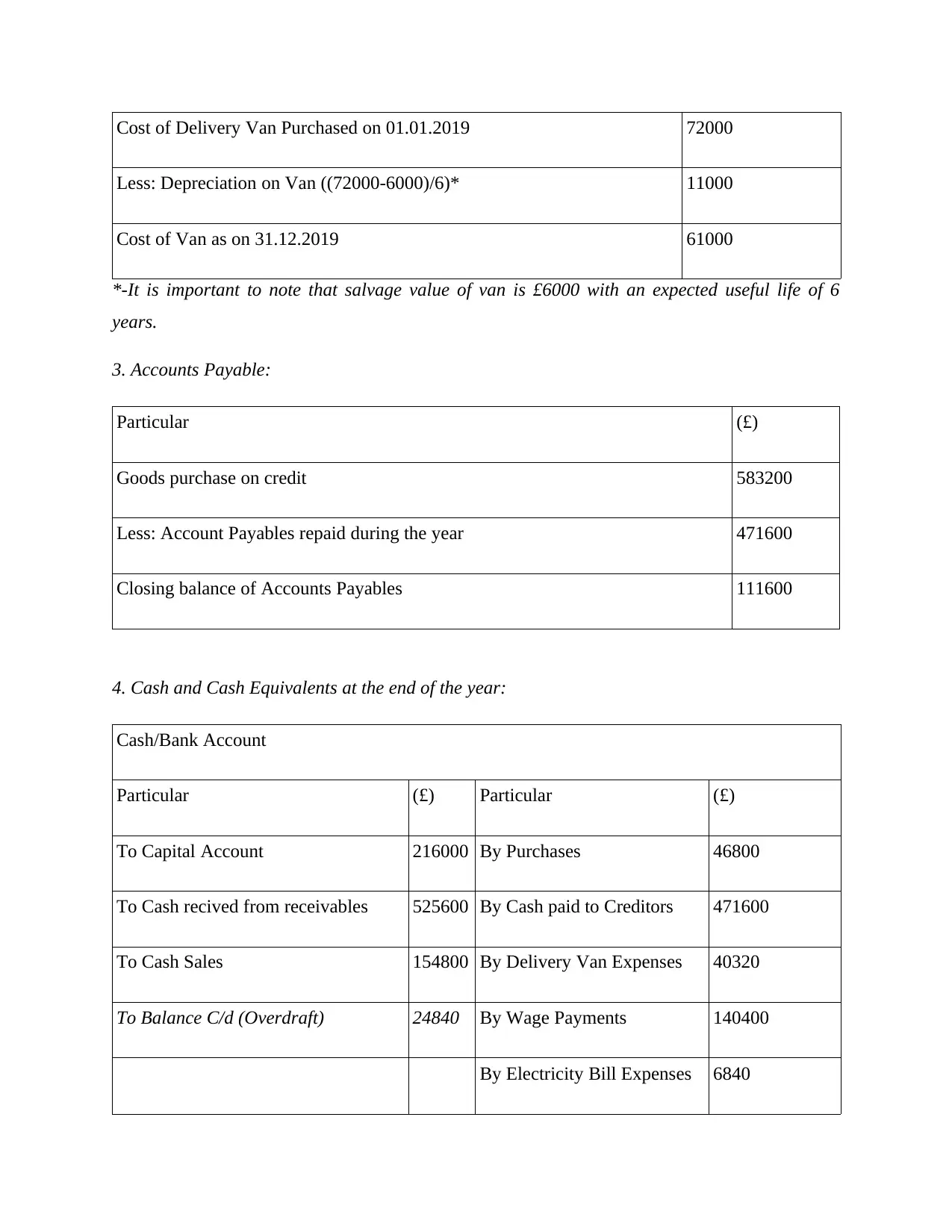
Cost of Delivery Van Purchased on 01.01.2019 72000
Less: Depreciation on Van ((72000-6000)/6)* 11000
Cost of Van as on 31.12.2019 61000
*-It is important to note that salvage value of van is £6000 with an expected useful life of 6
years.
3. Accounts Payable:
Particular (£)
Goods purchase on credit 583200
Less: Account Payables repaid during the year 471600
Closing balance of Accounts Payables 111600
4. Cash and Cash Equivalents at the end of the year:
Cash/Bank Account
Particular (£) Particular (£)
To Capital Account 216000 By Purchases 46800
To Cash recived from receivables 525600 By Cash paid to Creditors 471600
To Cash Sales 154800 By Delivery Van Expenses 40320
To Balance C/d (Overdraft) 24840 By Wage Payments 140400
By Electricity Bill Expenses 6840
Less: Depreciation on Van ((72000-6000)/6)* 11000
Cost of Van as on 31.12.2019 61000
*-It is important to note that salvage value of van is £6000 with an expected useful life of 6
years.
3. Accounts Payable:
Particular (£)
Goods purchase on credit 583200
Less: Account Payables repaid during the year 471600
Closing balance of Accounts Payables 111600
4. Cash and Cash Equivalents at the end of the year:
Cash/Bank Account
Particular (£) Particular (£)
To Capital Account 216000 By Purchases 46800
To Cash recived from receivables 525600 By Cash paid to Creditors 471600
To Cash Sales 154800 By Delivery Van Expenses 40320
To Balance C/d (Overdraft) 24840 By Wage Payments 140400
By Electricity Bill Expenses 6840
⊘ This is a preview!⊘
Do you want full access?
Subscribe today to unlock all pages.

Trusted by 1+ million students worldwide
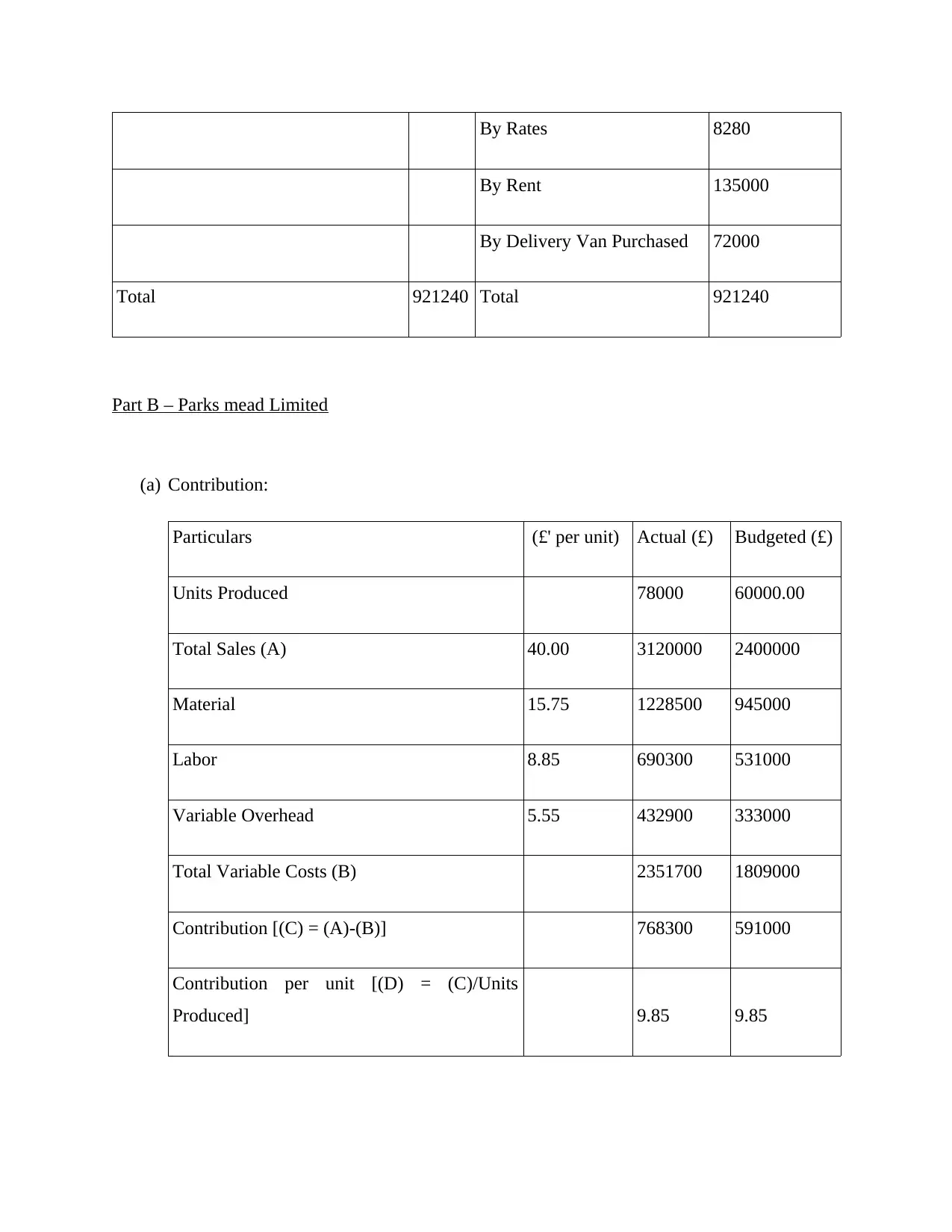
By Rates 8280
By Rent 135000
By Delivery Van Purchased 72000
Total 921240 Total 921240
Part B – Parks mead Limited
(a) Contribution:
Particulars (£' per unit) Actual (£) Budgeted (£)
Units Produced 78000 60000.00
Total Sales (A) 40.00 3120000 2400000
Material 15.75 1228500 945000
Labor 8.85 690300 531000
Variable Overhead 5.55 432900 333000
Total Variable Costs (B) 2351700 1809000
Contribution [(C) = (A)-(B)] 768300 591000
Contribution per unit [(D) = (C)/Units
Produced] 9.85 9.85
By Rent 135000
By Delivery Van Purchased 72000
Total 921240 Total 921240
Part B – Parks mead Limited
(a) Contribution:
Particulars (£' per unit) Actual (£) Budgeted (£)
Units Produced 78000 60000.00
Total Sales (A) 40.00 3120000 2400000
Material 15.75 1228500 945000
Labor 8.85 690300 531000
Variable Overhead 5.55 432900 333000
Total Variable Costs (B) 2351700 1809000
Contribution [(C) = (A)-(B)] 768300 591000
Contribution per unit [(D) = (C)/Units
Produced] 9.85 9.85
Paraphrase This Document
Need a fresh take? Get an instant paraphrase of this document with our AI Paraphraser
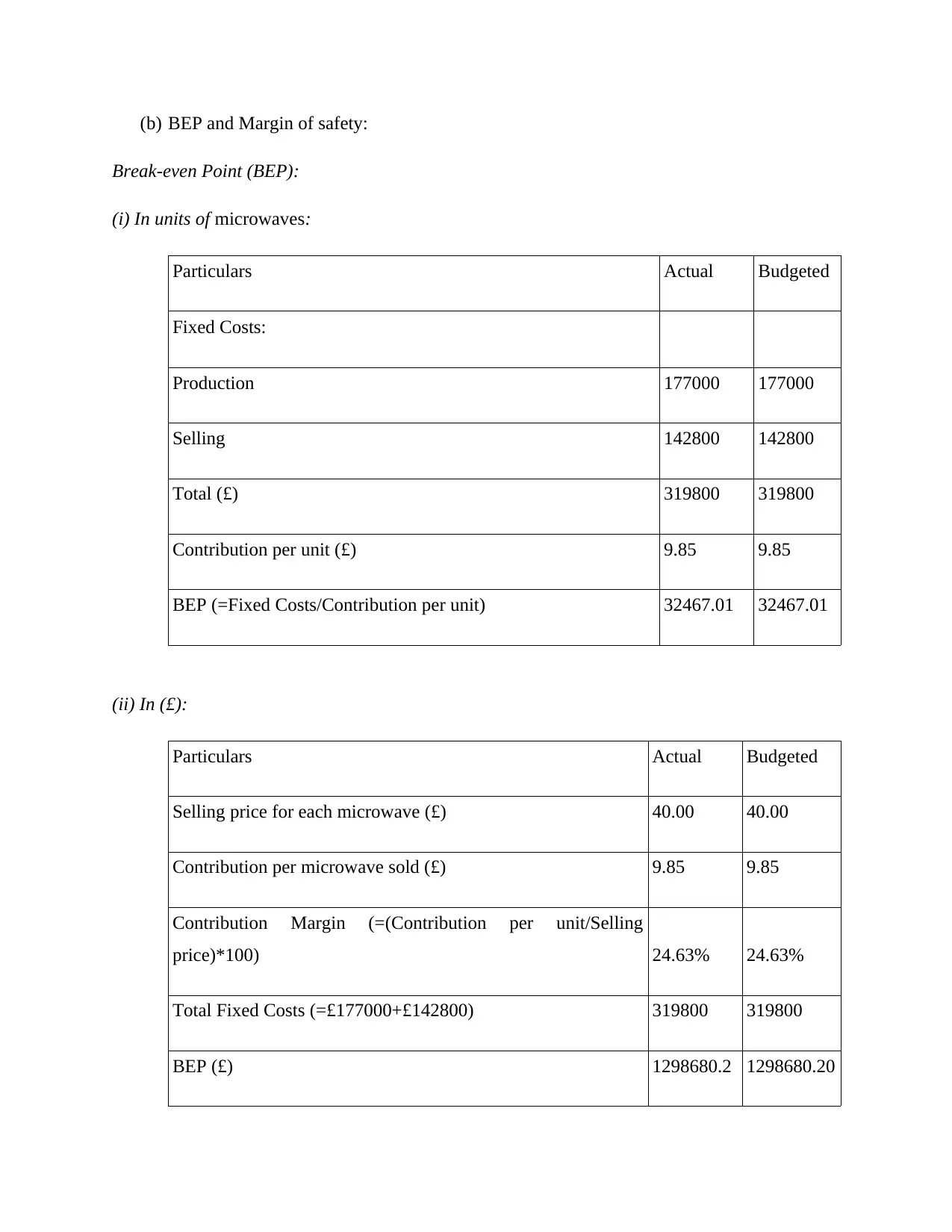
(b) BEP and Margin of safety:
Break-even Point (BEP):
(i) In units of microwaves:
Particulars Actual Budgeted
Fixed Costs:
Production 177000 177000
Selling 142800 142800
Total (£) 319800 319800
Contribution per unit (£) 9.85 9.85
BEP (=Fixed Costs/Contribution per unit) 32467.01 32467.01
(ii) In (£):
Particulars Actual Budgeted
Selling price for each microwave (£) 40.00 40.00
Contribution per microwave sold (£) 9.85 9.85
Contribution Margin (=(Contribution per unit/Selling
price)*100) 24.63% 24.63%
Total Fixed Costs (=£177000+£142800) 319800 319800
BEP (£) 1298680.2 1298680.20
Break-even Point (BEP):
(i) In units of microwaves:
Particulars Actual Budgeted
Fixed Costs:
Production 177000 177000
Selling 142800 142800
Total (£) 319800 319800
Contribution per unit (£) 9.85 9.85
BEP (=Fixed Costs/Contribution per unit) 32467.01 32467.01
(ii) In (£):
Particulars Actual Budgeted
Selling price for each microwave (£) 40.00 40.00
Contribution per microwave sold (£) 9.85 9.85
Contribution Margin (=(Contribution per unit/Selling
price)*100) 24.63% 24.63%
Total Fixed Costs (=£177000+£142800) 319800 319800
BEP (£) 1298680.2 1298680.20
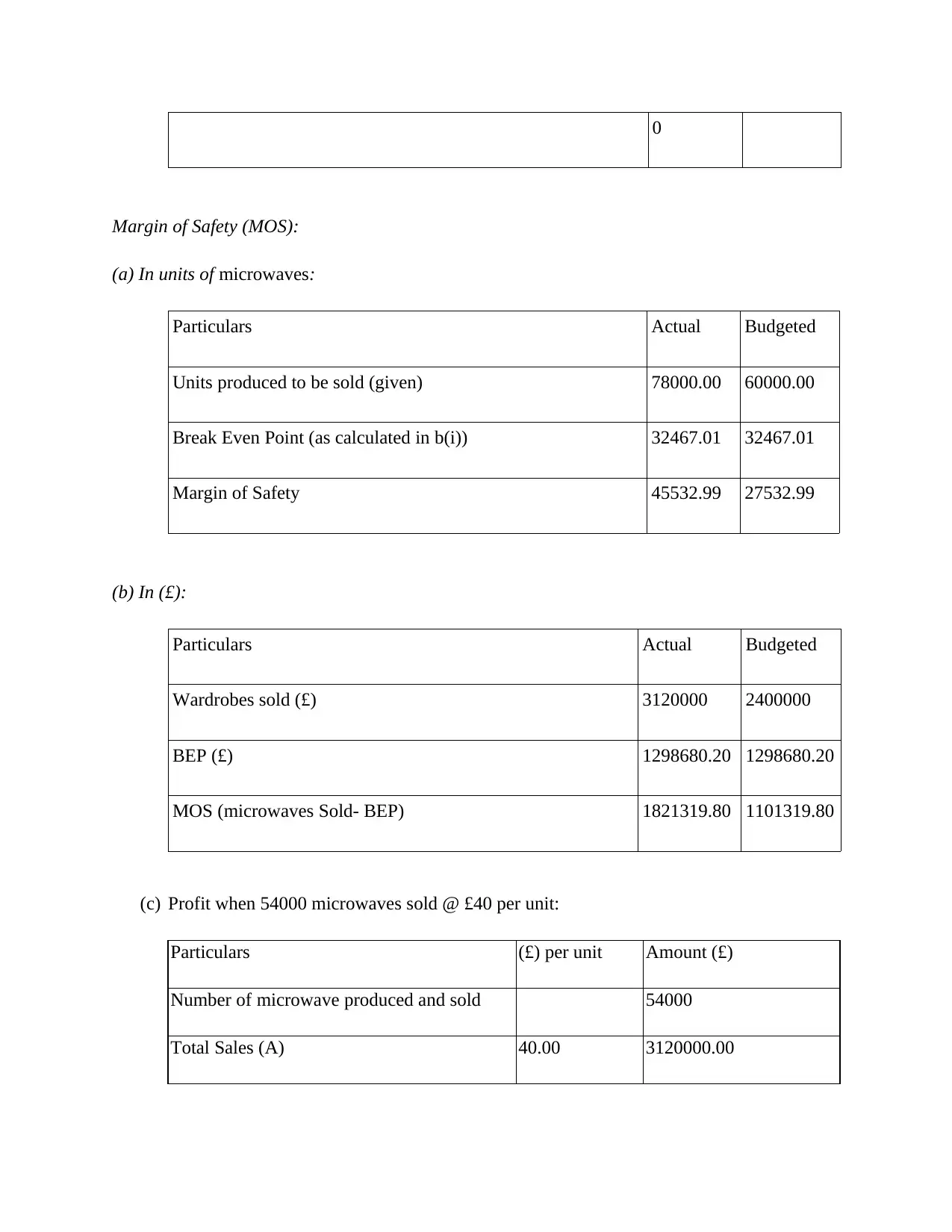
0
Margin of Safety (MOS):
(a) In units of microwaves:
Particulars Actual Budgeted
Units produced to be sold (given) 78000.00 60000.00
Break Even Point (as calculated in b(i)) 32467.01 32467.01
Margin of Safety 45532.99 27532.99
(b) In (£):
Particulars Actual Budgeted
Wardrobes sold (£) 3120000 2400000
BEP (£) 1298680.20 1298680.20
MOS (microwaves Sold- BEP) 1821319.80 1101319.80
(c) Profit when 54000 microwaves sold @ £40 per unit:
Particulars (£) per unit Amount (£)
Number of microwave produced and sold 54000
Total Sales (A) 40.00 3120000.00
Margin of Safety (MOS):
(a) In units of microwaves:
Particulars Actual Budgeted
Units produced to be sold (given) 78000.00 60000.00
Break Even Point (as calculated in b(i)) 32467.01 32467.01
Margin of Safety 45532.99 27532.99
(b) In (£):
Particulars Actual Budgeted
Wardrobes sold (£) 3120000 2400000
BEP (£) 1298680.20 1298680.20
MOS (microwaves Sold- BEP) 1821319.80 1101319.80
(c) Profit when 54000 microwaves sold @ £40 per unit:
Particulars (£) per unit Amount (£)
Number of microwave produced and sold 54000
Total Sales (A) 40.00 3120000.00
⊘ This is a preview!⊘
Do you want full access?
Subscribe today to unlock all pages.

Trusted by 1+ million students worldwide
1 out of 22
Related Documents
Your All-in-One AI-Powered Toolkit for Academic Success.
+13062052269
info@desklib.com
Available 24*7 on WhatsApp / Email
![[object Object]](/_next/static/media/star-bottom.7253800d.svg)
Unlock your academic potential
Copyright © 2020–2025 A2Z Services. All Rights Reserved. Developed and managed by ZUCOL.




